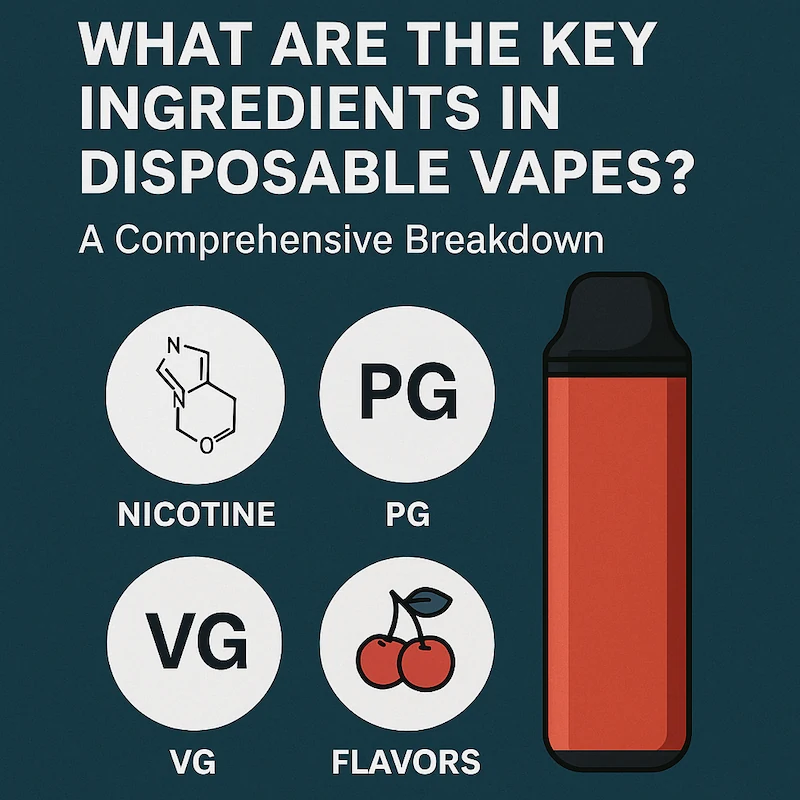Innehållsförteckning
ToggleHar du någonsin funderat på vad som finns i en engångsvape? Huvudingredienserna i dessa bärbara enheter är vanligtvis fyra: propylenglykol, vegetabiliskt glycerin, nikotin och smakämnen. Propylenglykol ger en mjuk känsla i halsen, medan vegetabiliskt glycerin gör ångan tjock. Blandningen av dessa två påverkar hur användaren inhalerar.
Nicotine — the addictive component of tobacco — varies in strength across different disposable vape brands. While fruit, candy, and other flavourings make it more pleasurable to breathe in, they can also create harmful chemicals like formaldehyde and acetaldehyde when heated to very high temperatures. According to CDC research on e-cigarette ingredients, common flavoring agents and nicotine formulations can release aldehydes when heated at high wattages. It is recommended that consumers not only focus on the basic list of “ingredients in disposable vapes” but also deeply understand the proportion and safety levels of each component. This will help them strike a balance between convenience and health risks and make more informed usage decisions. If you’re wondering whether these ingredients are safe for daily use, check out our guide on vape juice ingredients and potential health risks.
Vetenskapen bakom Vape för engångsbruk Ingredienser
Propylenglykol (PG) och vegetabiliskt glycerin (VG): E-vätskans grund
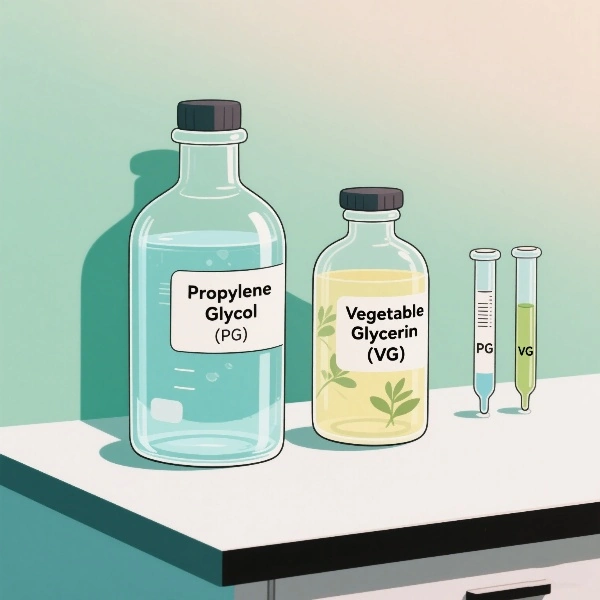
De två viktigaste ingredienserna i e-vätskor är propylenglykol (PG) och vegetabiliskt glycerin (VG). De har alla olika effekt på vapingupplevelsen:
- PG (propylenglykol)
- Detta ger dig en halskänsla som påminner om vanliga cigaretter, vilket är perfekt för mun-till-lung-användare (MTL) som vill ha den klassiska känslan.
- Det rinner lätt genom värmespiralen och gör smaken starkare, vilket är anledningen till att det används mycket i starka smakblandningar.
- VG (Vegetabiliskt glycerin)
- VG är känt för att producera tät, molnliknande ånga, vilket är populärt bland direktlungor (DL) som vill inhalera mycket.
- Det gör saker och ting lite sötare, men vid höga förhållanden (till exempel 80VG:20PG) kan det också göra smaken svagare.
The PG/VG mix affects your experience: most disposables use a 50:50 (balanced) or 70VG:30PG (vapor-focused) mix. High-PG blends (for example, 70PG:30VG) may irritate the throat for some users, while high-VG reduces harshness but can make the flavour less complex. 👉 Did you know that PG/VG ratios also affect how long vape juice lasts before it goes stale? Here’s a guide on vape juice expiration and storage tips.
Nikotin: Den beroendeframkallande komponenten avkodad

Den huvudsakliga beroendeframkallande ingrediensen, nikotin, finns i två huvudsakliga former i engångscigaretter:
- Nikotinsalter
- Dessa salter är bundna till organiska syror (t.ex. bensoesyra), som minskar halsirritation. Detta innebär att starka läkemedel (t.ex. 50 mg/ml) lätt kan inhaleras.
- De absorberas snabbare (inom 5-10 minuter) och efterliknar effekterna av cigaretter, vilket gör dem populära för att hjälpa människor att sluta röka.
- Freebase Nikotin
- Den ursprungliga formen är starkare vid höga koncentrationer och är vanligare i vapes med låg styrka (3-6 mg/mL).
Nicotine salts are the most common type of disposable vape because they are smooth. However, always check the concentration: 30mg/mL (3%) is good for people who smoke less, while 50mg/mL (5%) is better for heavy smokers transitioning from traditional cigarettes. Nicotine is addictive. If you use too much of it, you may feel sick or have a racing heart. If you’re exploring options with less nicotine, see some low nicotine vape in Snagvape.
Smakämnen: Lockelsen och riskerna med Vape-smak
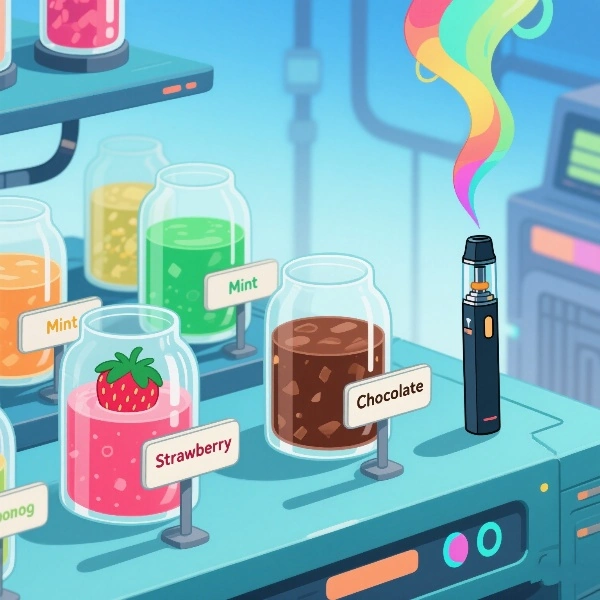
Smaktillsatser gör det mer tilltalande att vapinga, men de kan också vara farliga:
- Vanliga typer
- Fruktig (t.ex. etylbutyrat för äpple)
- Mentol (svalkande känsla)
- Dessert (t.ex. vanillin för vanilj)
- Värmedrivna risker
- When food is cooked at high temperatures (above 250°C), some of the flavour compounds can change into harmful substances, like benzaldehyde (a possible cancer-causing chemical). If you’ve ever noticed your e-liquid darkening after heavy use, here’s why vape juice turns brown and what high heat does to flavors.
- Diacetyl is linked to lung disease. It is banned in regulated markets, but it may still be in products that are not regulated or illegal. See NIH’s toxicology data on diacetyl and benzaldehyde for details on their health impacts.
Välj märken som listar smakingredienserna. "Naturliga smaker" kan vara vagt, så välj produkter som listar specifika föreningar eller säger "diacetylfri" på etiketten.
Dolda faror: Metaller i spolar och biprodukter från pyrolys
- Material för nätrullar
- Many single-use products use nickel-chromium coils, which can release small amounts of metals when heated repeatedly. Higher-quality devices may use stainless steel, which reduces exposure to metals. Price often reflects build quality — see our 2025 disposable vape price guide to understand which models use safer materials. According to JAMA Cardiology 2022, repeated exposure to nickel-chromium aerosols may have cardiovascular implications over time.
- PG/VG Pyrolys
- PG och VG producerar färre skadliga kemikalier än traditionella cigaretter när de förbränns vid normala temperaturer (under 220°C). Men ju varmare spolen är, desto mer sannolikt är det att aldehyder som formaldehyd kommer att produceras.
Experttips för säkrare vaping
- Välj klokt baserat på PG/VG-förhållanden
- MTL-användare: Välj högre PG-blandningar (t.ex. 60:40) för en starkare smak.
- DL-vaporisatörer: Välj blandningar med högre VG (t.ex. 70:30) för en mjukare och grumligare inhalering.
- Prioritera transparenta varumärken
- Leta efter produkter som har testats av ett tredjepartslaboratorium. Detta kommer att visa om ingredienserna är säkra.
- Avoid products with vague or unverified ingredient listings or that are just “trendy”. If you’re looking for safer long-term options, check out our 2025 guide to the best healthy vape alternatives.
- Använd måttligt och undvik överhettning
- De flesta av dessa är utformade för att använda mindre än 15 watt effekt. Andas inte för hårt eller för länge, eftersom det kan göra att spolen blir för varm.
Slutlig takeaway
Engångsvapor är praktiska, men det är viktigt att veta hur man använder dem på ett säkert sätt. Om du förstår vad som finns i din enhet kan du göra val som är rätt för dig. Välj välkända, ärliga varumärken och använd dessa enheter på ett säkert sätt.
Avslöjar de dolda hälsoriskerna med Vape-ingredienser för engångsbruk: Skadliga biprodukter från atomisering vid hög temperatur
Engångsvape är populära eftersom de är lätta att använda, men de innehåller en blandning av kemikalier som kan vara skadliga för hälsan. Den här artikeln handlar om kortsiktiga olägenheter, långsiktiga risker och hur detta påverkar utsatta grupper. Den bygger på forskning som utfördes 2023-2024.
Kortsiktiga hälsoeffekter: Omedelbara varningstecken för användning av engångsvideor
Att använda engångsvapor kan orsaka fysiska reaktioner direkt, särskilt för nya användare eller personer som vaporiserar mycket. Dessa kortsiktiga signaler visar oss tidigt vilka de större riskerna kan vara.
1. Irritation av andningsvägarna: Det första tecknet på aerosolskada
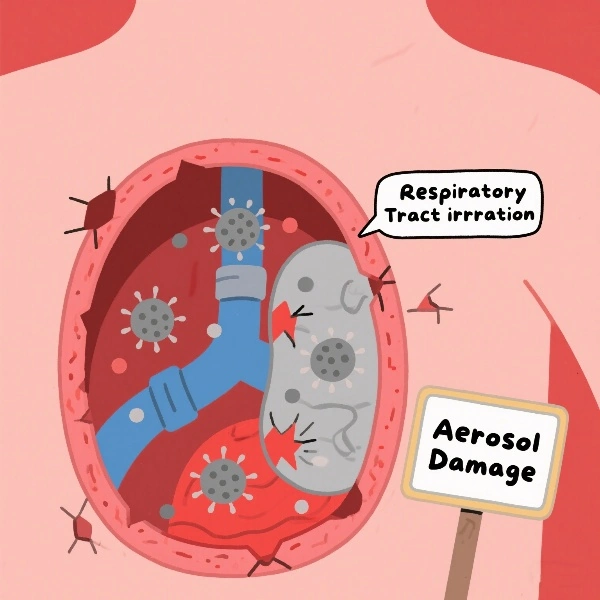
Inandning av vape aerosol kan orsaka:
- En brännande känsla i halsen, en plötslig torrhosta eller ett ständigt behov av att rensa halsen. Detta orsakas ofta av propylenglykol (PG) eller höga nikotinnivåer.
- Om du har astma eller allergier kan mentolbaserade kylvätskor orsaka en astmaattack.
Viktigt att ta med sig: Om du har ont i halsen, gå till låg-PG-blandningar och undvik mentol om du har svårt att andas.
2. Överbelastning av nikotin: Neurologiska och kardiovaskulära symtom
Om du röker för mycket nikotin (t.ex. genom att snabbt andas in 5% styrka vapes) kan det leda till:
- Om du känner dig yr, hjärtat slår mycket snabbt och händerna är svettiga beror det förmodligen på att du just har tagit ett bloss på din cigarett. Det beror på att nikotinet i tobaken får kroppen att frigöra adrenalin (British Pharmacological Society, 2023). Sometimes these symptoms can also occur with degraded e-liquid — learn how to recognize expired vape juice safely.
- Allvarliga fall kan inkludera magsmärtor eller att man blir sjuk. Detta är särskilt riskabelt för personer med hjärtproblem.
Riskvarning: Om du är en ny användare (och inte röker) bör du börja med 1,5-2% nikotin (15-20 mg/ml). Om du bara röker lite kanske du vill prova 3% för att undvika att använda för mycket.
3. Akut nikotintoxicitet: När ska man söka omedelbar hjälp?
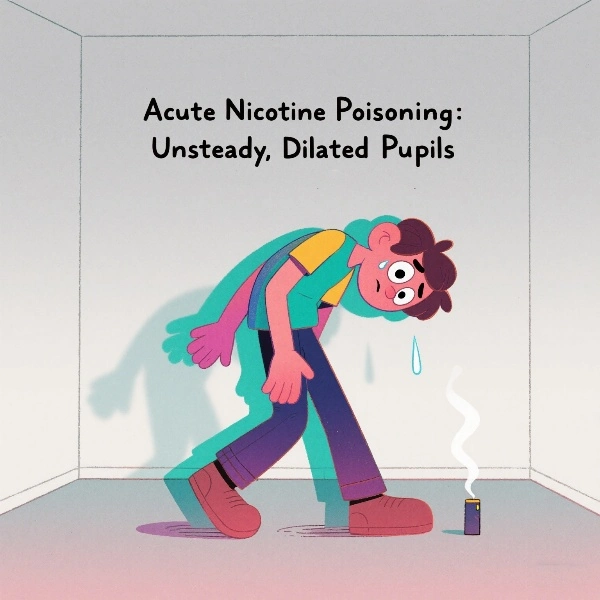
Om du tar mer än 50 mg nikotin (motsvarande en hel 5% engångsvape) kan du känna dig förvirrad, gå ostadigt och dina pupiller kan vidgas. Om du har detta problem måste du genast uppsöka läkare. Detta beror på att det kan leda till att du slutar andas.
Långsiktiga hälsorisker: De tysta farorna med kronisk vaping
De säljs som ett "säkrare alternativ", men de kan orsaka allvarliga problem med lung- och hjärthälsan om du använder dem under lång tid.
1. Kumulativ lungskada vid inandning av aerosol
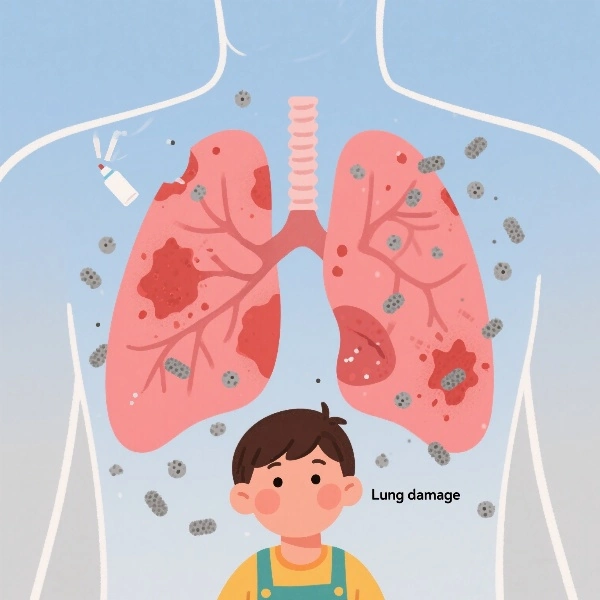
- A 2023 study on e-cigarette use found that people who use e-cigarettes are 34% more likely to get asthma (HR=1.34) and 57% more likely to get COPD (linked to >20 puffs/day).
- Smaken på maten kan påverka immunförsvaret i lungorna. Till exempel kan formaldehyd, som finns i vissa livsmedel, skada lungornas immunförsvar. Även om vitamin E-acetat inte är tillåtet i lagliga produkter, finns det fortfarande i 12% av olagliga vapes på svarta marknaden.
Åtgärdssteg: Försök hitta varumärken som har "aldehydfria" certifikat, och köp inte smaksatta produkter som inte har kontrollerats av de personer som borde göra det.
2. Kronisk nikotinpåverkan på kardiovaskulär hälsa
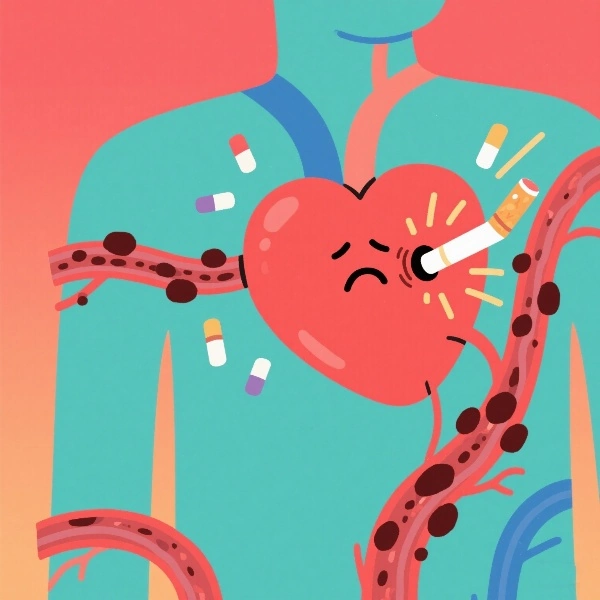
- Nikotin har visat sig störa hjärtfrekvensvariabiliteten (HRV), som är en viktig markör för plötslig hjärtdöd (JAMA Cardiology, 2022).
- Det förvärrar ateroskleros genom 22% genom att bryta ner "dåligt" kolesterol. Djurstudier tyder på att nikotin i låg dos kan orsaka epigenetisk vaskulär skada (Cirkulationsforskning 2024), men detta måste bekräftas i studier på människor.
Råd om rationell användning: Om du försöker sluta röka ska du välja en produkt med mindre än 3% nikotin och en tydlig ingrediensförteckning. Du bör också kontrollera din lung- och hjärthälsa en gång om året.
Sårbara grupper: Vem löper störst risk att utsättas för engångsvape?
Vissa grupper av människor löper större risk på grund av sin biologi.
1. Ungdomar: Långsiktiga konsekvenser av tidig exponering

- En studie från 2024 av Pediatrics fann att tonåringar som vapnar är 41% mer benägna att ha astma (OR = 1,41) och att deras lungor blir sämre 27% snabbare.
- Nikotin påverkar utvecklingen av prefrontala cortex hos unga människor, vilket kan leda till uppmärksamhetsproblem.
Föräldrarnas guide: Se upp för vapes som luktar och smakar frukt, som marknadsförs till tonåringar, och prata om riskerna med dem.
2. Gravida personer: Risker för mor och foster

- Nikotin passerar från mamman till barnet genom moderkakan, vilket kan göra att det tar längre tid för barnet att börja växa inuti mamman. Djurstudier visar en 60% högre risk för metabolt syndrom hos avkomman, men det finns inte mycket bevis för människor.
- Det medicinska rådet är att kvinnor inte ska dricka alkohol alls under graviditeten.
3. Patienter med respiratoriska sjukdomar: Förvärring av befintliga tillstånd
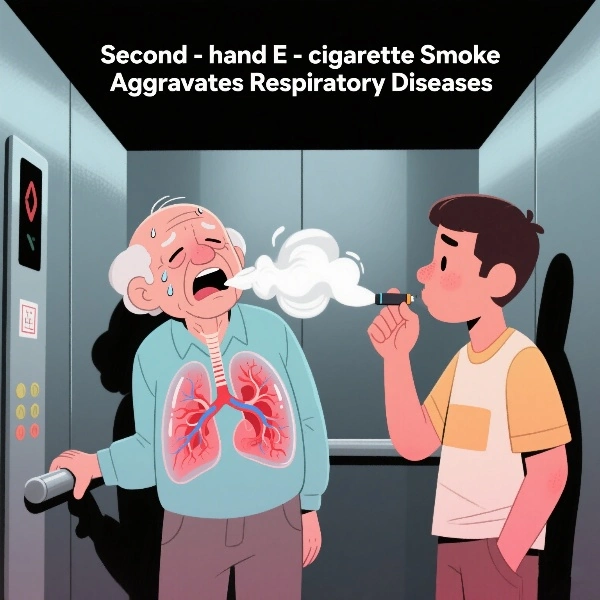
- Personer med KOL som röker e-cigaretter varje dag löper tre gånger större risk att få sina symtom förvärrade snabbt, och deras lungfunktion är 55% sämre (Thorax 2023).
- Menthol cools the airways, but we need more proof that it can also hide other problems (Respiratory Research, 2024).
Medicinsk rådgivning: Om du funderar på att använda vapes som ett alternativ till rökning är det alltid bäst att först kontakta en lungläkare.
Slutsats: Prioritering av hälsa framför bekvämlighet vid användning av e-cigaretter
Vapes för engångsbruk är inte säkra. Från omedelbar halsirritation till långsiktiga lung- och hjärtskador, och en ökad risk för tonåringar, gravida och patienter, kräver deras effekter försiktighet. De kan hjälpa vissa att sluta röka, men för att få bästa möjliga resultat måste du vara öppen med hur du använder dem, gå på regelbundna hälsokontroller och följa råd från utbildad personal.
Sista tipset: Sätt varumärken med tredjeparts labbrapporter högst upp på din lista, undvik enheter med hög nikotinhalt och hög effekt och fundera på säkrare alternativ som nikotinersättningsterapi. Din långsiktiga hälsa är viktigare än att känna dig bekväm på kort sikt.
VANLIGA FRÅGOR: Vape-ingredienser för engångsbruk och Hälsa Risker
F1: Vilket är mest skadligt: Vapes för engångsbruk eller traditionella cigaretter?
Båda är dåliga för din hälsa, och vapes är inte ett "säkert alternativ". Vanliga cigaretter avger tjära, kolmonoxid och kemikalier som kan orsaka cancer, som bensopyren, när de bränns. Dessa kemikalier kan orsaka lungcancer, hjärtsjukdomar och stroke. Engångsvape innehåller, även om de är tjärfria,:
- Beroendeframkallande nikotin: Det orsakar problem med hjärt- och hjärnutvecklingen hos tonåringar.
- Giftiga aerosoler: Heating e-liquid can produce formaldehyde and acetaldehyde; high-power vapes (more than 30 watts) may release 1.5 times more aldehydes than cigarette smoke (Journal of Aerosol Science, 2024).
- Olagliga tillsatser: Även om olagliga vapes förbjöds 2019, visade en undersökning 2024 av CDC att 12% av olagliga vapes fortfarande innehåller en skadlig kemikalie som kallas diacetyl, som är kopplad till ett lungtillstånd som kallas bronkiolit obliterans.
Viktig skillnad: Cigaretter har visat sig orsaka cancer, medan oreglerade vapes utgör unika risker från smakämnen och metallpartiklar. Ingetdera är säkert för långvarig användning.
F2: Är 0-nikotin-vapes helt säkra?
Nej. "Nikotinfri" betyder inte riskfri:
- Toxiner orsakade av värme: Vid normala temperaturer (≤220°C) producerar PG/VG låga aldehydnivåer, men högeffektsapparater (>30W) kan generera formaldehyd i 1,5 gånger högre nivåer än en cigarett (Aerosolvetenskap 2024).
- Aromämnen Irriterande ämnen: Menthol is one of the ingredients that has been linked to a 25% higher risk of chronic cough in people who use it every day (American Thoracic Society, 2024).
- Frågor om märkning: FDA:s undersökning 2024 visade att 15% av "nikotinfria" vapes innehöll spår av nikotin (≥0,05 mg/ml), sannolikt från korskontaminering.
Expertrådgivning: If you don’t smoke, and especially if you’re a teenager, you should not use any kind of vape. This is because even nicotine-free vapes can cause problems with your breathing and might make you start smoking. However, some users find nicotine-free devices helpful for reducing stress — discover how nicotine-free vapes may ease anxiety.
F3: Hur kan jag kontrollera om det finns förbjudna ingredienser i vapes?
Se till att du är säker genom att vara öppen och följa reglerna:
- Regulatoriska godkännanden: Leta efter produkter som har certifierats av FDA PMTA (USA) eller EU TPD (Europa). Dessa certifieringar kräver strikta säkerhetstester.
- Tydlig märkning: Lagliga produkter ska innehålla:
- Nikotinstyrka (t.ex. "20mg/mL")
- PG/VG-förhållande (t.ex. "50:50")
- Specifika smakkomponenter (t.ex. "naturlig mint [mentol]")
- Testning av tredje part: Begär ISO 17025-certifierade laboratorierapporter som verifierar:
- Diacetyl ≤0,01 mg/mL
- Tungmetaller (nickel ≤0,1 μg/puff, krom ≤0,05 μg/puff)
- Undvik produkter med hög risk: År 2024 återkallade FDA 80% vapes med "naturlig smak" eftersom de innehöll furaner som kan irritera luftvägarna.
Q4: Orsakar Vape-ingredienser långvarig lungskada?
Ja, det är sant. Vape-aerosoler innehåller mycket små partiklar (100-500 nm) som går ner i lungorna och orsakar skada över tid:
- Kvarhållande av partiklar: Metaller som nickeloxid kan stanna kvar i lungorna i 2-5 år (Perspektiv på miljö och hälsa 2024).
- Ökade risker:
- Astma: Långtidsanvändare (de som röker 10 eller fler cigaretter per dag) är 38% mer benägna att skada sin hälsa.
- KOL: Det finns en högre risk för dagliga användare, och detta är kopplat till hur ofta de röker.
- Lungfibros: År 2023 genomfördes en studie på 15% av EVALI överlevande upptäckte att de hade bestående ärrbildning i lungorna.
Slutsats: Även vaping några gånger om året kan orsaka permanent lungskada. Om du försöker sluta röka bör du tänka på att använda FDA-godkända metoder som nikotinersättningsterapi istället för vapes.
Want to find safer ways to transition away from vapes? Explore healthy vape alternatives and responsible usage tips.
